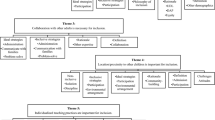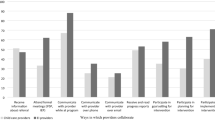Abstract
Children with disabilities take part in child care programs across the country every day. However, existing research is lacking on how infants and toddlers with disabilities are supported in these inclusion efforts, particularly from the perspectives of child care and early intervention (EI) providers. In this article, we describe the results of a statewide survey of U.S. child care and EI providers (N = 991; n = 620 child care providers, n = 371 EI providers) on their beliefs and experiences in inclusion and perceived factors that support and hinder the inclusion of very young children with disabilities in child care settings. Our study results indicate that although providers value inclusion and identify many benefits for children, families, and professionals, several barriers exist to effectively implement meaningful inclusion. Despite advances in legislation, policy, and recommended practices, little has changed in the inclusion of infants and toddlers; therefore, recommendations for policy, practice, and research are included. Recommendations include increased training and mentoring for providers and formal inclusion of child care providers in inclusion supported by state policy and continued research.
Similar content being viewed by others
References
Booth, C. L., & Kelly, J. F. (1999). Child care and employment in relation to infants’ disabilities and risk factors. American Journal on Mental Retardation, 104, 117–130.
Bruder, M. B., & Dunst, C. J. (2005). Personnel preparation in recommended early intervention practices: Degree of emphasis on across discipline. Topics in Early Childhood Special Education, 25, 25–33
Bruns, D. A., & Mogharrenban, C. C. (2007). The gap between beliefs and practices: Early childhood practitioners’ perceptions about inclusion. Journal of Research in Childhood Education, 21, 229–241. https://doi.org/10.1080/02568540709594591.
Buell, M. J., Garmel-McCormick, M., & Hallam, R. A. (1999). Inclusion in a childcare context: Experiences and attitudes of family childcare providers. Topics in Early Childhood Special Education, 19, 217–224.
Buysse, V., Wesley, P. W., & Keyes, L. (1998). Implementing early childhood inclusion: Barrier and support factors. Early Childhood Research Quarterly, 13, 169–184.
Child Care Aware of America. (2013). We can do better: Child Care Aware of America’s ranking of state child care center regulations and oversight: 2013 update. Retrieved from http://www.usa.childcareaware.org/advocoacy/reports-research/wcdb.
Cook Pletcher, L., & Younggren, N. O. (2013). The early intervention workbook: Essential practices for quality services. Baltimore: Brookes Publishing Co.
Copple, C., & Bredekamp, S. (2009). Developmentally appropriate practice in early childhood programs serving children from birth to age 8. Washington, DC: National Association for the Education of Young Children.
DEC/NAEYC. (2009). Early childhood inclusion: A joint position statement of the Division for Early Childhood (DEC) and the National Association for the Education of Young Children (NAEYC). Chapel Hill: The University of North Carolina, FPG Child Development Institute.
DeMoor, J. M. H., Van Waesberghe, B. T. M., Hosman, J. B. L., Jaeken, D., & Miedema, S. (1993). Early intervention for children with developmental disabilities: Manifesto of the Eurlyaid working party. International Journal of Rehabilitation Research, 16, 23–31.
DeVore, S., & Bowers, B. (2006). Childcare for children with disabilities: Families search for specialized and cooperative childcare partnerships. Infants & Young Children, 19, 203–212.
Dinnebeil, L. A., McInerney, W., Fox, C., & Juchartz-Pendry, K. (1998). An analysis of the perceptions and characteristics of childcare personnel regarding inclusion of young children with special needs in community-based programs. Topics in Early Childhood Special Education, 18, 118–128.
Division for Early Childhood of the Council for Exceptional Children. (2014). DEC recommended practices for early intervention/early childhood special education. Retrieved from http://www.dec-sped.org/recommendedpractices.
European Agency for Development in Special Needs Education. (2003). Early childhood intervention: Analysis of situations in Europe, key aspects and recommendations. Retrieved from https://www.european-agency.org/sites/default/files/early-childhood-intervention-analysis-of-situations-in-europe-key-aspects-and-recommendations_eci_en.pdf.
European Association of Service Providers for Persons with Disabilities. (2016). EASPD statement of early childhood intervention. Retrieved from http://www.easpd.eu/sites/default/files/sites/default/files/Policy/Education/easpd_statement_on_early_childhood_intervention.pdf.
Guralnick, M. J. (2008). International perspectives on early intervention: A search for common ground. Journal of Early Intervention, 30, 90–101. https://doi.org/10.1177/1053815107313483.
Harbin, G. L., McWilliam, R. A., & Gallagher, J. J. (2000). Services for young children with disabilities and their families. In J. P. Shonkoff & S. J. Meisels (Eds.), Handbook of early childhood intervention (pp. 387–415). New York: Cambridge Press.
Kagan, S. L., & Neuman, M. J. (2000). Early care and education: Current issues and future strategies. In J. P. Shonkoff & S. J. Meisels (Eds.), Handbook of early childhood intervention (pp. 339–360). New York: Cambridge Press.
Mohay, H., & Reid, E. (2006). The inclusion of children with a disability in child care: The influences of experience, training and attitudes of child care staff. Australian Journal of Early Childhood, 31, 35–42.
Mulvihill, B. A., Shearer, D., & Van Horn, M. L. (2002). Training, experiences, and child care providers’ perceptions of inclusion. Early Childhood Research Quarterly, 17, 197–215.
Odom, S. L. (2000). Preschool inclusion: What we know and where we go from here. Topics in Early Childhood Special Education, 20, 20–27.
Poon, K. K., & Yang, X. (2016). The student profile, service delivery model, and support practices of four early childhood intervention environments in Singapore. Asia Pacific Journal of Education, 36, 437–449. https://doi.org/10.1080/02188791.2014.940030.
Shonkoff, J. P., & Phillips, D. A. (2000). From neurons to neighborhoods: The science of early childhood development. Washington, DC: National Academy Press.
United Nations Children’s Fund. (2013). The state of the world’s children: Children with disabilities. New York: Division of Communication, UNICEF.
U.S. Census Bureau. (2013, April). Who’s minding the kids? Child care arrangements: Spring 2011. Retrieved from http://www.census.gov/prod/2013pubs/p70-135.pdf.
U.S. Department of Education, Office of Special Education and Rehabilitative Services, Office of Special Education Programs (2015). 37th Annual Report to Congress on the Implementation of the Individuals with Disabilities Education Act, Washington, DC.
U.S. Department of Health and Human Services & U.S. Department of Education. (2015). Policy statement on inclusion of children with disabilities in early childhood programs. Retrieved from http://www2.ed.gov/policy/speced/guid/earlylearning/joint-statement-full-text.pdf.
Wall, S., Kisker, E. E., Peterson, C. A., Carta, J. J., & Jeon, H. J. (2006). Child care for low-income children with disabilities: Access, quality, and parental satisfaction. Journal of Early Intervention, 28, 283–298.
Wesley, P. W., & Buysse, V. (1994). Barriers and support to early childhood inclusion. Chapel Hill, NC: Frank Porter Graham Child Development Center.
Wesley, P. W., Buysse, V., & Skinner, D. (2001). Early interventionists’ perspectives on professional comfort as consultants. Journal of Early Intervention, 24, 112–128.
Whitebook, M., McLean, C., & Austin, L. J. E. (2016). Early childhood workforce index 2016. Berkeley, CA: Center for the Study of Child Care Employment, University of California, Berkeley.
Whitebook, M., Phillips, D., & Howes, C. (2014). Worthy work, STILL unlivable wages: The early childhood workforce 25 years after the National Child Care Staffing Study. Berkeley, CA: Center for the Study of Child Care Employment, University of California, Berkeley.
Wiart, L., Kehler, H., Rempel, G., & Tough, S. (2014). Current state of inclusion of children with special needs in child care programmes in one Canadian province. International Journal of Inclusive Education, 18, 345–358. https://doi.org/10.1080/13603116.2013.767386.
Wolery, M., Bashers, M. S., & Neitzel, J. C. (2002). Ecological congruence assessment for classroom activities and routines. Topics in Early Childhood Special Education, 22, 131–142.
Workgroup on Principles and Practices in Natural Enivornments of the U.S. Department of Education Office of Special Education Programs. (2008, March). Agreed upon mission and key principles for providing early intervention services in natural environments. Retrieved from http://ectacenter.org/~pdfs/topics/families/Finalmissionandprinciples3_11_08.pdf.
Acknowledgements
The contents of this study were supported by funding from the U.S. Department of Health and Human Services Administration of Children and Families (90YE0163, Project Officer Ann Rivera) and U.S. Department of Education (H325D110037, Project Officer Dawn Ellis). However, those contents do not necessarily represent the policy of the U.S. Departments of Health and Human Services and Education, and you should not assume endorsement by the Federal Government.
Author information
Authors and Affiliations
Corresponding author
Rights and permissions
About this article
Cite this article
Weglarz-Ward, J.M., Santos, R.M. & Timmer, J. Factors That Support and Hinder Including Infants with Disabilities in Child Care. Early Childhood Educ J 47, 163–173 (2019). https://doi.org/10.1007/s10643-018-0900-3
Published:
Issue Date:
DOI: https://doi.org/10.1007/s10643-018-0900-3




